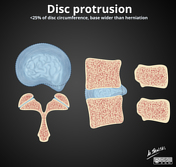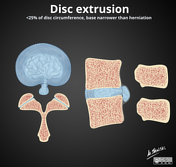Intervertebral disc disease nomenclature
Updates to Article Attributes
Lumbar disc disease is a common problem and the source of a great deal of imaging. A consistent approach to describing intervertebral disc disease is therefore necessary. Terms such as bulge, protrusion, extrusion, sequestration and migration all have specific meanings although their definition varies from publication to publication. In this article the recommendations from The American Society of Spine Radiology, The American Society of Neuroradiology and The American Spine Society have been used.
In general the following terms/conditions will apply to an intervertebral disc:
- normal
- desiccation
- annular fissure
- bulge
-
herniation
-
protrusion
- broad based/focal
- contained/not contained
-
extrusion
- migration
- sequestration
-
protrusion
- pseudodisc of anterolisthesis
In the case of disc herniation then the abnormally displaced nucleus polposus should be described in terms of its position in both axial and sagittal planes.
Axial localisation
Most sizable disc herniations will occupy more than one zone:
- central
- subarticular
- foraminal
- extraforaminal or lateral
- anterior
Sagittal localisation
The pedicle and disc are used as reference points. Disc herniations may extend to:
- disc level: confined to between the vertebral endplates
- suprapedicular: between superior endplate and superior border of pedicle
- pedicular: at the level of the pedicle
- infrapedicular: below lower margin of the pedicle to the inferior endplate
-<p><a href="/articles/lumbar-disc-disease">Lumbar disc disease</a> is a common problem and the source of a great deal of imaging. A consistent approach to describing <a href="/articles/intervertebral-disc">intervertebral disc</a> disease is therefore necessary. Terms such as <a title="Disc bulge" href="/articles/disc-bulge">bulge</a>, <a title="Disc protrusion" href="/articles/disc-protrusion">protrusion</a>, <a title="Disc extrusion" href="/articles/disc-extrusion">extrusion</a>, sequestration and migration all have specific meanings although their definition varies from publication to publication. In this article the recommendations from <a href="http://theassr.org/">The American Society of Spine Radiology</a>, <a href="http://www.asnr.org">The American Society of Neuroradiology</a> and <a title="The American Spine Society" href="https://www.spine.org">The American Spine Society</a> have been used.</p><p>In general the following terms/conditions will apply to an <a href="/articles/intervertebral-disc">intervertebral disc:</a></p><ul>- +<p><a href="/articles/lumbar-disc-disease">Lumbar disc disease</a> is a common problem and the source of a great deal of imaging. A consistent approach to describing <a href="/articles/intervertebral-disc">intervertebral disc</a> disease is therefore necessary. Terms such as <a href="/articles/disc-bulge">bulge</a>, <a href="/articles/disc-protrusion">protrusion</a>, <a href="/articles/disc-extrusion">extrusion</a>, sequestration and migration all have specific meanings although their definition varies from publication to publication. In this article the recommendations from <a href="http://theassr.org/">The American Society of Spine Radiology</a>, <a href="http://www.asnr.org">The American Society of Neuroradiology</a> and <a href="https://www.spine.org">The American Spine Society</a> have been used.</p><p>In general the following terms/conditions will apply to an <a href="/articles/intervertebral-disc">intervertebral disc:</a></p><ul>
Image ( destroy )
Image ( destroy )
Image ( destroy )
Image 6 Diagram ( create )

Image 7 Annotated image ( update )

Image 8 Diagram ( create )

Image 9 Annotated image ( update )

Image 10 Diagram ( create )

Image 11 Diagram ( update )








 Unable to process the form. Check for errors and try again.
Unable to process the form. Check for errors and try again.